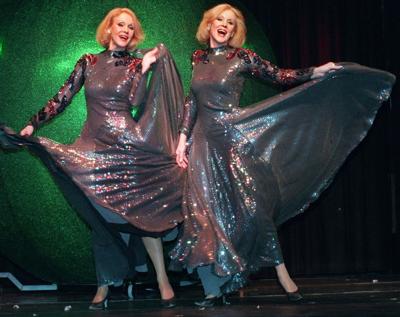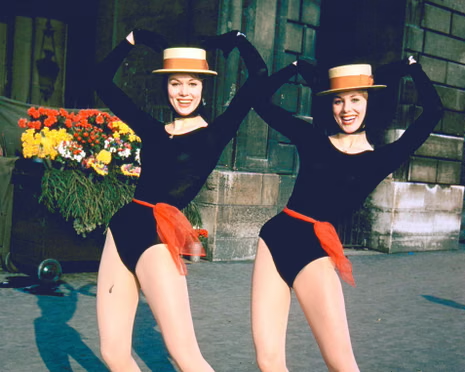For nearly seven decades, Alice and Ellen Kessler stood as symbols of elegance, harmony, and artistic brilliance. Long before the era of viral videos, digital stages, and social-media fame, they captivated audiences the old-fashioned way — through talent, discipline, presence, and unmatched professionalism.
Their synchronized steps, radiant smiles, and unmistakable twin charm made them instantly recognizable from Germany to Italy, France, the United States, and beyond.
And now, with their peaceful passing at the age of 89, the world is pausing to remember two women whose careers shaped an entire generation of entertainment. But their final chapter — choosing to end their lives together through medically assisted dying on November 19 at their home near Munich — has brought a new wave of reflection, admiration, and emotion.
It was a farewell as intentional and unified as the way they lived, danced, performed, and dreamed: side by side, inseparable to the very end.
A Life Spanning Nearly a Century — Born into a Changing World
Alice and Ellen Kessler entered the world in 1936, in the shadow of a Europe on the brink of turmoil. As children, they grew up during World War II, witnessing hardship, displacement, and societal uncertainty. Yet even in those early years, the twins showed an innate sense of rhythm and musicality that set them apart. Their mother, recognizing their rare synchronicity, enrolled them in ballet and performance classes as soon as opportunities allowed.

By age 11, the sisters had joined the Leipzig Opera Ballet, a remarkable achievement for girls so young — and a first glimpse of the remarkable work ethic that would later define them. It wasn’t fame they chased then, but expression. The stage became a place where they felt free, creative, and whole.
From Post-War Germany to International Stardom
The 1950s were transformative not just for the entertainment industry, but for the Kessler twins themselves. West Germany was rebuilding its identity, and artists played a major role in restoring joy and cultural vibrancy. Alice and Ellen quickly became symbols of that post-war revival.
Their talent caught global attention when they represented West Germany in the 1959 Eurovision Song Contest. Their performance, polished and perfectly synchronized, signaled that they were more than local stars — they were international entertainers.
From that moment forward, their rise was unstoppable.
A Duo That Defined a Generation of Television
As television exploded across Europe, the Kessler twins became household names. Their appearances on popular shows like Studio Uno in Italy showcased their versatility: they weren’t simply dancers, nor merely singers — they were full entertainers.
Their style was unmistakable:
-
chic costumes,
-
glamorous silhouettes,
-
flawless timing,
-
warm, engaging smiles,
-
and an elegance that never depended on scandal or controversy.
Audiences across Europe tuned in not just to watch them perform, but to feel uplifted by their presence. They represented beauty without arrogance, talent without ego, and discipline without rigidity. They were adored not only for what they did, but for who they were.

Performing with Legends: Sinatra, Astaire, and More
Their excellence opened doors that few European performers could dream of. Over the years, Alice and Ellen performed alongside some of the greatest entertainers in history:
-
Frank Sinatra, who admired their precision,
-
Fred Astaire, who praised their artistry,
-
Bing Crosby,
-
Dean Martin,
-
and other monumental figures of the 20th-century stage.
Sharing the spotlight with such icons solidified their place in entertainment history. They were no longer just European stars — they were global cultural treasures.
A Playboy Cover That Made Headlines
In an era when modesty shaped female representation on screen, the Kessler twins made bold headlines by appearing on the cover of Playboy. But unlike typical features of the magazine, their appearance was celebrated not for shock value, but for its sophistication. They embodied glamour without vulgarity — something that made their image iconic and widely respected even decades later.
Seven Decades of Togetherness: A Bond Beyond Sisterhood
More than their fame, what people admired most was their unity. No artistic partnership on Earth lasted as long — or as gracefully — as theirs.
They rehearsed together.
They traveled together.
They performed together.
They aged together.
And ultimately, they made their final decision together.
Their bond was not merely genetic; it was emotional, creative, spiritual. They understood one another in ways that transcended language — communicating through glances, breath, timing, and rhythm.
Choosing Their Final Moment: A Decision Years in the Making
Their passing through medically assisted dying is perhaps the most deeply personal choice they ever made. Since 2019, Germany has allowed the option under specific legal and medical guidelines. Authorities confirmed that the Kessler sisters acted freely, responsibly, and with full clarity of mind.
Their decision was not shocking to those who understood their philosophy. In earlier interviews, the twins shared their wish:
“We came into this world together, lived every stage of life together, and we want to rest together.”
They had planned for a shared urn, a shared resting place — a final affirmation of the unity the world had admired for nearly a century.
Tributes That Spanned the Globe
After news of their passing broke, tributes poured in from across Europe and beyond.
Radio Monte Carlo wrote:
“Inseparable even in farewell — a unique artistic couple who left an indelible imprint on the collective imagination.”
Fans who grew up watching the sisters expressed gratitude, nostalgia, and admiration. Younger generations, discovering them for the first time through online archives, expressed awe at their timeless elegance.
The twins didn’t just perform — they shaped culture.

The End of an Era
The death of Alice and Ellen Kessler symbolizes more than the loss of two beloved entertainers; it marks the closing of a chapter in European artistic history. They came from a time when performance demanded perfection, when rehearsals stretched for hours, and when entertainers built careers on talent — not headlines.
Their departure feels, to many, like the dimming of a golden spotlight.
But their legacy continues through:
-
archival footage of their dazzling performances,
-
the artists they inspired,
-
the audiences they delighted,
-
and the cultural influence they left behind.
The world may never again see a duo like them.
As tributes continued pouring in from across Europe, broadcasters replayed vintage performances, and fans revisited grainy black-and-white clips from decades ago, it became increasingly clear that the passing of Alice and Ellen Kessler was more than a moment of remembrance — it was a moment of reflection. It encouraged people to pause, to consider not just the beauty of their careers, but the emotional and cultural significance of two women who built nearly seventy years of artistry on discipline, kindness, and unity.
A Life Lived in Harmony — and a Farewell Reflecting That Harmony
The Kessler twins were never performers who relied on controversy, sensational headlines, or scandal to stay relevant. They thrived in a world that demanded excellence — a world where audiences measured artists by the elegance of their movement, the richness of their voices, and the sincerity of their on-stage presence.
Even in their final decision, this integrity and intentionality remained.
Choosing medically assisted dying was not a gesture of despair; it was an expression of autonomy. According to close acquaintances, they approached their final days with clarity, calmness, and a remarkable sense of peace. They had lived fully, loved deeply, and contributed generously — and when the time came, they wished to leave the world in the same way they had lived in it: gracefully, thoughtfully, and together.
Their farewell was not a tragedy; it was a final act of unity.
Why Their Passing Resonated So Deeply
The global reaction to their passing may seem surprising to those who did not grow up with their music, their dance, or their television appearances. But for millions, Alice and Ellen were woven into the soundtrack of childhood, the glamour of television variety shows, the golden age of European pop culture, and the elegance of a time when entertainment felt more refined.
For older audiences, their passing marked:
-
the fading of a generation,
-
a reminder of youth long gone,
-
and the end of an entertainment era defined by class and discipline.
For younger audiences, discovering their performances online became an unexpected lesson in artistic history.
Their influence transcended decades. They became symbols not just of art, but of resilience — women who lived through war, cultural revolutions, and the evolution of the entertainment industry, while retaining their signature charm and dignity.

The Power of Inseparable Identity
What made the Kessler twins extraordinary wasn’t simply that they were identical, but that their careers embodied a uniquely shared identity. Not many artistic duos can claim such longevity. Not many siblings can maintain such unity over nearly ninety years.
They never drifted into rivalry. They never separated for personal fame. They understood themselves as one harmonious entity — complementary halves of a single brilliance.
This bond became a lesson in:
-
loyalty,
-
unconditional companionship,
-
and the rare beauty of choosing to walk through life side by side.
In a world that often celebrates individualism, their story was a reminder that togetherness can be just as powerful — and sometimes far more meaningful.
A Reflection on Their Cultural and Emotional Impact
Their passing sparked renewed discussions on how artists of the past shaped the emotional rhythms of generations. In homes across Germany, Italy, Austria, and France, families gathered around televisions to watch their holiday specials, musical numbers, and dance routines. Their faces appeared on magazine covers, but they were also present in living rooms, in laughter, in shared family memories, and in countless evenings spent enjoying simple entertainment.
Many fans recounted memories such as:
-
grandparents humming the songs they performed,
-
families gathering for Studio Uno on Saturday nights,
-
and mothers teaching daughters their graceful dance steps.
Their legacy was not just artistic — it was emotional, nostalgic, and deeply personal.
The Twin Flame That Illuminated European Entertainment
In the 1960s and 70s, there were artists who performed, and there were artists who transformed the atmosphere simply by stepping onto a stage. Alice and Ellen belonged to the latter. They didn’t rely on special effects, modern technology, or digital manipulation. They relied on craft.
Their synchronized choreography was precise without being mechanical.
Their vocals were soft yet full of warmth.
Their presence radiated optimism, poise, and timeless glamour.
For decades, they represented a hopeful, elegant version of Europe — one that valued beauty, harmony, and cultural unity.
The Personal Side of the Kessler Twins
Beyond the glittering costumes and television appearances, Alice and Ellen lived quiet, grounded lives. They were known for:
-
kindness toward fans,
-
humility around colleagues,
-
disciplined daily routines,
-
dedication to their family,
-
and an aversion to drama or public feuds.
Their ability to remain wholesome and gracious, even in an industry famous for egos, made them beloved not just by audiences, but by fellow performers.
The Final Chapter: Dignity, Choice, and Mutual Devotion
In their later years, as performances slowed and public appearances became rare, the twins dedicated themselves to the peaceful routines of everyday life near Munich. They stayed active, maintained their health as best they could, and continued their lifelong habit of doing everything together — cooking, traveling, reading, reminiscing, and visiting friends.
As age began to place weight on their bodies, their minds remained sharp. Their unity grew even stronger, and they often expressed gratitude for having lived such long, fulfilling lives.
Their final decision was rooted in:
-
love for each other,
-
respect for autonomy,
-
and a desire to avoid prolonged suffering.
It was not an act of sadness, but an act of synchronized closure — a final dance, performed offstage, but just as elegant as the ones they performed under bright lights.
How Future Generations Will Remember Them
The Kessler twins will be remembered not simply as entertainers, but as cultural guardians of a rapidly vanishing era. An era where:
-
performers trained for years,
-
variety shows brought families together,
-
European entertainment was flourishing,
-
and the world was captivated by simplicity and elegance.
They will be remembered as artists who brought joy, as women who embodied grace, and as sisters whose bond remained unbroken from birth to their final breath.
Their Legacy Today
Their influence continues in:
-
restored archival footage,
-
tribute documentaries,
-
music history courses,
-
digital platforms that reintroduce their work to new audiences.
Younger generations discovering their performances often respond with the same sense of wonder older audiences felt decades ago. Their artistry is timeless because it speaks beyond trend or technology — it speaks to beauty, precision, and soul.
A Farewell Worthy of Legends
As the world reflects on the lives of Alice and Ellen Kessler, one truth stands out:
Their final act — departing together, peacefully and intentionally — was the ultimate expression of who they were.
Two hearts.
Two artists.
Two sisters.
One lifelong story.
A story of harmony, discipline, love, and unity that will continue to move the world for generations to come.
May Alice and Ellen Kessler rest in peace —
together, as they lived, as they performed, and as they always chose to be.
For nearly seven decades, Alice and Ellen Kessler stood as symbols of elegance, harmony, and artistic brilliance. Long before the era of viral videos, digital stages, and social-media fame, they captivated audiences the old-fashioned way — through talent, discipline, presence, and unmatched professionalism.
Their synchronized steps, radiant smiles, and unmistakable twin charm made them instantly recognizable from Germany to Italy, France, the United States, and beyond.
And now, with their peaceful passing at the age of 89, the world is pausing to remember two women whose careers shaped an entire generation of entertainment. But their final chapter — choosing to end their lives together through medically assisted dying on November 19 at their home near Munich — has brought a new wave of reflection, admiration, and emotion.
It was a farewell as intentional and unified as the way they lived, danced, performed, and dreamed: side by side, inseparable to the very end.
A Life Spanning Nearly a Century — Born into a Changing World
Alice and Ellen Kessler entered the world in 1936, in the shadow of a Europe on the brink of turmoil. As children, they grew up during World War II, witnessing hardship, displacement, and societal uncertainty. Yet even in those early years, the twins showed an innate sense of rhythm and musicality that set them apart. Their mother, recognizing their rare synchronicity, enrolled them in ballet and performance classes as soon as opportunities allowed.

By age 11, the sisters had joined the Leipzig Opera Ballet, a remarkable achievement for girls so young — and a first glimpse of the remarkable work ethic that would later define them. It wasn’t fame they chased then, but expression. The stage became a place where they felt free, creative, and whole.
From Post-War Germany to International Stardom
The 1950s were transformative not just for the entertainment industry, but for the Kessler twins themselves. West Germany was rebuilding its identity, and artists played a major role in restoring joy and cultural vibrancy. Alice and Ellen quickly became symbols of that post-war revival.
Their talent caught global attention when they represented West Germany in the 1959 Eurovision Song Contest. Their performance, polished and perfectly synchronized, signaled that they were more than local stars — they were international entertainers.
From that moment forward, their rise was unstoppable.
A Duo That Defined a Generation of Television
As television exploded across Europe, the Kessler twins became household names. Their appearances on popular shows like Studio Uno in Italy showcased their versatility: they weren’t simply dancers, nor merely singers — they were full entertainers.
Their style was unmistakable:
-
chic costumes,
-
glamorous silhouettes,
-
flawless timing,
-
warm, engaging smiles,
-
and an elegance that never depended on scandal or controversy.
Audiences across Europe tuned in not just to watch them perform, but to feel uplifted by their presence. They represented beauty without arrogance, talent without ego, and discipline without rigidity. They were adored not only for what they did, but for who they were.

Performing with Legends: Sinatra, Astaire, and More
Their excellence opened doors that few European performers could dream of. Over the years, Alice and Ellen performed alongside some of the greatest entertainers in history:
-
Frank Sinatra, who admired their precision,
-
Fred Astaire, who praised their artistry,
-
Bing Crosby,
-
Dean Martin,
-
and other monumental figures of the 20th-century stage.
Sharing the spotlight with such icons solidified their place in entertainment history. They were no longer just European stars — they were global cultural treasures.
A Playboy Cover That Made Headlines
In an era when modesty shaped female representation on screen, the Kessler twins made bold headlines by appearing on the cover of Playboy. But unlike typical features of the magazine, their appearance was celebrated not for shock value, but for its sophistication. They embodied glamour without vulgarity — something that made their image iconic and widely respected even decades later.
Seven Decades of Togetherness: A Bond Beyond Sisterhood
More than their fame, what people admired most was their unity. No artistic partnership on Earth lasted as long — or as gracefully — as theirs.
They rehearsed together.
They traveled together.
They performed together.
They aged together.
And ultimately, they made their final decision together.
Their bond was not merely genetic; it was emotional, creative, spiritual. They understood one another in ways that transcended language — communicating through glances, breath, timing, and rhythm.
Choosing Their Final Moment: A Decision Years in the Making
Their passing through medically assisted dying is perhaps the most deeply personal choice they ever made. Since 2019, Germany has allowed the option under specific legal and medical guidelines. Authorities confirmed that the Kessler sisters acted freely, responsibly, and with full clarity of mind.
Their decision was not shocking to those who understood their philosophy. In earlier interviews, the twins shared their wish:
“We came into this world together, lived every stage of life together, and we want to rest together.”
They had planned for a shared urn, a shared resting place — a final affirmation of the unity the world had admired for nearly a century.
Tributes That Spanned the Globe
After news of their passing broke, tributes poured in from across Europe and beyond.
Radio Monte Carlo wrote:
“Inseparable even in farewell — a unique artistic couple who left an indelible imprint on the collective imagination.”
Fans who grew up watching the sisters expressed gratitude, nostalgia, and admiration. Younger generations, discovering them for the first time through online archives, expressed awe at their timeless elegance.
The twins didn’t just perform — they shaped culture.

The End of an Era
The death of Alice and Ellen Kessler symbolizes more than the loss of two beloved entertainers; it marks the closing of a chapter in European artistic history. They came from a time when performance demanded perfection, when rehearsals stretched for hours, and when entertainers built careers on talent — not headlines.
Their departure feels, to many, like the dimming of a golden spotlight.
But their legacy continues through:
-
archival footage of their dazzling performances,
-
the artists they inspired,
-
the audiences they delighted,
-
and the cultural influence they left behind.
The world may never again see a duo like them.
As tributes continued pouring in from across Europe, broadcasters replayed vintage performances, and fans revisited grainy black-and-white clips from decades ago, it became increasingly clear that the passing of Alice and Ellen Kessler was more than a moment of remembrance — it was a moment of reflection. It encouraged people to pause, to consider not just the beauty of their careers, but the emotional and cultural significance of two women who built nearly seventy years of artistry on discipline, kindness, and unity.
A Life Lived in Harmony — and a Farewell Reflecting That Harmony
The Kessler twins were never performers who relied on controversy, sensational headlines, or scandal to stay relevant. They thrived in a world that demanded excellence — a world where audiences measured artists by the elegance of their movement, the richness of their voices, and the sincerity of their on-stage presence.
Even in their final decision, this integrity and intentionality remained.
Choosing medically assisted dying was not a gesture of despair; it was an expression of autonomy. According to close acquaintances, they approached their final days with clarity, calmness, and a remarkable sense of peace. They had lived fully, loved deeply, and contributed generously — and when the time came, they wished to leave the world in the same way they had lived in it: gracefully, thoughtfully, and together.
Their farewell was not a tragedy; it was a final act of unity.
Why Their Passing Resonated So Deeply
The global reaction to their passing may seem surprising to those who did not grow up with their music, their dance, or their television appearances. But for millions, Alice and Ellen were woven into the soundtrack of childhood, the glamour of television variety shows, the golden age of European pop culture, and the elegance of a time when entertainment felt more refined.
For older audiences, their passing marked:
-
the fading of a generation,
-
a reminder of youth long gone,
-
and the end of an entertainment era defined by class and discipline.
For younger audiences, discovering their performances online became an unexpected lesson in artistic history.
Their influence transcended decades. They became symbols not just of art, but of resilience — women who lived through war, cultural revolutions, and the evolution of the entertainment industry, while retaining their signature charm and dignity.

The Power of Inseparable Identity
What made the Kessler twins extraordinary wasn’t simply that they were identical, but that their careers embodied a uniquely shared identity. Not many artistic duos can claim such longevity. Not many siblings can maintain such unity over nearly ninety years.
They never drifted into rivalry. They never separated for personal fame. They understood themselves as one harmonious entity — complementary halves of a single brilliance.
This bond became a lesson in:
-
loyalty,
-
unconditional companionship,
-
and the rare beauty of choosing to walk through life side by side.
In a world that often celebrates individualism, their story was a reminder that togetherness can be just as powerful — and sometimes far more meaningful.
A Reflection on Their Cultural and Emotional Impact
Their passing sparked renewed discussions on how artists of the past shaped the emotional rhythms of generations. In homes across Germany, Italy, Austria, and France, families gathered around televisions to watch their holiday specials, musical numbers, and dance routines. Their faces appeared on magazine covers, but they were also present in living rooms, in laughter, in shared family memories, and in countless evenings spent enjoying simple entertainment.
Many fans recounted memories such as:
-
grandparents humming the songs they performed,
-
families gathering for Studio Uno on Saturday nights,
-
and mothers teaching daughters their graceful dance steps.
Their legacy was not just artistic — it was emotional, nostalgic, and deeply personal.
The Twin Flame That Illuminated European Entertainment
In the 1960s and 70s, there were artists who performed, and there were artists who transformed the atmosphere simply by stepping onto a stage. Alice and Ellen belonged to the latter. They didn’t rely on special effects, modern technology, or digital manipulation. They relied on craft.
Their synchronized choreography was precise without being mechanical.
Their vocals were soft yet full of warmth.
Their presence radiated optimism, poise, and timeless glamour.
For decades, they represented a hopeful, elegant version of Europe — one that valued beauty, harmony, and cultural unity.
The Personal Side of the Kessler Twins
Beyond the glittering costumes and television appearances, Alice and Ellen lived quiet, grounded lives. They were known for:
-
kindness toward fans,
-
humility around colleagues,
-
disciplined daily routines,
-
dedication to their family,
-
and an aversion to drama or public feuds.
Their ability to remain wholesome and gracious, even in an industry famous for egos, made them beloved not just by audiences, but by fellow performers.
The Final Chapter: Dignity, Choice, and Mutual Devotion
In their later years, as performances slowed and public appearances became rare, the twins dedicated themselves to the peaceful routines of everyday life near Munich. They stayed active, maintained their health as best they could, and continued their lifelong habit of doing everything together — cooking, traveling, reading, reminiscing, and visiting friends.
As age began to place weight on their bodies, their minds remained sharp. Their unity grew even stronger, and they often expressed gratitude for having lived such long, fulfilling lives.
Their final decision was rooted in:
-
love for each other,
-
respect for autonomy,
-
and a desire to avoid prolonged suffering.
It was not an act of sadness, but an act of synchronized closure — a final dance, performed offstage, but just as elegant as the ones they performed under bright lights.
How Future Generations Will Remember Them
The Kessler twins will be remembered not simply as entertainers, but as cultural guardians of a rapidly vanishing era. An era where:
-
performers trained for years,
-
variety shows brought families together,
-
European entertainment was flourishing,
-
and the world was captivated by simplicity and elegance.
They will be remembered as artists who brought joy, as women who embodied grace, and as sisters whose bond remained unbroken from birth to their final breath.
Their Legacy Today
Their influence continues in:
-
restored archival footage,
-
tribute documentaries,
-
music history courses,
-
digital platforms that reintroduce their work to new audiences.
Younger generations discovering their performances often respond with the same sense of wonder older audiences felt decades ago. Their artistry is timeless because it speaks beyond trend or technology — it speaks to beauty, precision, and soul.
A Farewell Worthy of Legends
As the world reflects on the lives of Alice and Ellen Kessler, one truth stands out:
Their final act — departing together, peacefully and intentionally — was the ultimate expression of who they were.
Two hearts.
Two artists.
Two sisters.
One lifelong story.
A story of harmony, discipline, love, and unity that will continue to move the world for generations to come.
May Alice and Ellen Kessler rest in peace —
together, as they lived, as they performed, and as they always chose to be.





